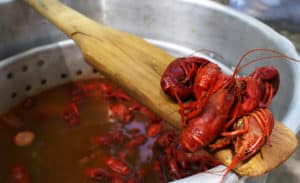As a caterer who specializes in Southern-style seafood boils, I’ve been asked many questions about crawfish over the years. But one question that I get asked more than any other is, “Do you have to purge crawfish?”
Without hesitation, I tell people, Yes, you absolutely have to purge crawfish before cooking them. In fact, purging is one of the most important steps in preparing crawfish for a boil.
In this post, I’ll explain why purging is so crucial and show you how to do it properly to ensure that your crawfish are safe, delicious, and free from any unwanted grit or debris.

Why Purging Crawfish Is Necessary
Purging crawfish is essential because these creatures are bottom-feeders that live in muddy waters. They often carry dirt, sand, and other debris inside their digestive systems.
In some cases, crawfish may also be purged to remove any unwanted flavors.
For example, if they have been feeding on a particular type of vegetation that imparts an unpleasant taste, purging can help remove this flavor and improve the overall quality of the crawfish.
If you don’t purge them correctly, this grit can end up in your crawfish boil, affecting the taste and texture of your food.
The Importance of Purging for Safety
Apart from affecting the taste and texture of the crawfish, the failure to purge them correctly can pose health risks to those consuming them.
Purging helps eliminate impurities and bacteria that may be harmful to human health.
When crawfish are not purged correctly, there is a risk of transmitting diseases such as cholera, typhoid, and hepatitis to those who consume them.
Therefore, purging crawfish is essential to ensure food safety and prevent food-borne illnesses.
What is Purged Crawfish?
Purged crawfish refers to crawfish that have been cleaned and prepared for cooking.
Specifically, purging involves soaking and rinsing the crawfish in fresh water to allow them to expel any impurities they may have ingested.
These impurities can include mud, dirt, sand, and other debris, which can affect the taste, texture, and safety of the crawfish if not removed.

How is Crawfish Purged?
The process of purging crawfish typically involves soaking and rinsing them in fresh water.
The purging process helps to stimulate the crawfish’s digestive system, encouraging them to expel any impurities they may have ingested.
Regardless of the solution used, the crawfish are typically soaked and rinsed before cooking, allowing them to fully purge any impurities from their digestive system.
It’s worth noting that the process of purging crawfish can be somewhat time-consuming, and it’s not always necessary to do so.
If you’re purchasing crawfish from a reputable supplier, they may have already been purged, meaning that the impurities have been removed before they reach your kitchen.
However, if you’re unsure whether your crawfish have been purged or not, it’s always better to err on the side of caution and soak them before cooking.
Check out my latest post where I explore the age-old question of whether you should purge crawfish or not, and learn how to ensure the best taste and texture.

Consequences of Not Purging Crawfish
If you’re planning to cook and eat crawfish, purging them is an essential step in the preparation process. However, what happens if you don’t purge your crawfish?
Let’s delve into the consequences of skipping this crucial step.
Gritty Texture: When you don’t purge crawfish, the sand and grit in their digestive tracts will not be removed. Consequently, you’ll end up with a gritty texture when you eat them.
This can be unpleasant and ruin your overall dining experience.
Gritty crawfish can also be challenging to clean, making it harder to remove the sand and grit from their shells.
Unpleasant Taste: Apart from the gritty texture, crawfish that haven’t been purged may also have an unpleasant taste.
The sand and dirt in their digestive tracts can give the crawfish a muddy flavor, which is not desirable when preparing them for consumption.
Additionally, this can be difficult to mask with other flavors, ruining the dish you’re trying to create.
Reduced Shelf Life: Crawfish that haven’t been purged may have a shorter shelf life than purged crawfish. The sand and dirt in their digestive tracts can contribute to bacterial growth, spoiling the crawfish more quickly.
This means that they may not last as long in the refrigerator, which can be problematic if you plan to use them for a meal later in the week.
Health Risks: Not purging crawfish can also pose health risks. The sand and dirt in their digestive tracts may contain harmful bacteria, such as E. coli or Salmonella, which can cause food poisoning if ingested.
Consuming contaminated crawfish can lead to vomiting, diarrhea, and other severe health problems.
Therefore, it’s essential to purge your crawfish to minimize the risk of food-borne illness.

Proper Technique for Purging Crawfish
Purging crawfish is a crucial step that cannot be overlooked if you want to achieve a perfect taste and texture when preparing this seafood delicacy.
In this section, we will discuss a reliable method for purging crawfish to ensure that they are free of any unpleasant taste or texture.
1.) Prepare the Container
To start, you will need an ice chest or a wash tub to hold the crawfish. Dump the crawfish into the container and ensure that they are evenly distributed.
2.) Fill the Container with Water
Using a water hose, fill the container with water until the crawfish are completely covered. You should ensure that the water level is sufficient to allow the crawfish to move around freely during the purging process.
3.) Stir the Crawfish
Using a paddle or a similar tool, stir the crawfish around gently to allow the water to move in and out of their digestive tracts. As you stir, pick out any dead crawfish that float to the top of the container during the purging process.
4.) Drain and Repeat
Once you have stirred the crawfish for a few minutes, dump out the water and repeat the process.
You may need to repeat this process several times until the water turns clear, indicating that the crawfish are free of any sand or grit in their digestive tracts.
5.) Set Aside the Crawfish
Once the water is clear, set aside the crawfish in a shady spot until you are ready to boil them.
It is essential to keep them in a cool, shaded area to prevent them from dying before cooking.
If you’re looking for a way to make the crawfish purging process easier, you should check out the Cowboy’s Crawfish Washer – it’s a game changer!

6.) Boil the Crawfish
When you are ready to boil the crawfish, drain the water from the container and place them in a pot of boiling water. Your crawfish are now ready to be seasoned and enjoyed.
If you’re new to boiling crawfish or simply looking to refine your technique, I highly recommend checking out my guide on how to boil crawfish.
Conclusion
Purged crawfish refers to crawfish that have been cleaned and prepared for cooking by soaking them and rinsing in water to allow them to expel any impurities they may have ingested.

Purging crawfish is necessary to ensure that they are safe to consume, free from harmful bacteria and parasites, and have a clean, sweet flavor and tender texture.
While it may take a bit of extra effort to purge the crawfish before cooking them, the end result is well worth it
